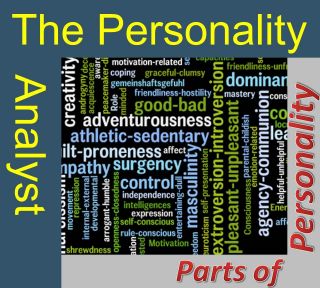Personality
Finding New Parts of Personality
Where do the ideas for parts of personality come from?
Posted February 10, 2014

Psychologists have proposed over 400 parts of personality, from readily-recognized parts that are regularly studied such as extraversion and humility to neglected and rarely-studied parts such as the enantiodromia.
A “part of personality” is a pattern that we learn to label—it’s really our mental representation of an aspect of personality that we recognize again and again in other people and perhaps in ourselves as well. This personality pattern may be expressed in how a person thinks or feels, or in the individual's behavior. For example, Carl Jung used the term "enantiodromia" to describe the little voice inside us that contradicts what we say aloud. If we exclaim to our colleague “What a great job you’re doing!” and then wonder, “Does she really know what she’s doing?,” that contrary voice is the enantiodromia at work, as Jung saw it.
Although we might perceive a given quality in several people, our perception of the possible existence of a part of personality is distinct from its actual existence. The actual existence of a part of personality depends upon some empirical demonstrations of its reality. Usually this involves developing some kind of measure of the mental quality of interest. In essence, well-constructed intelligence tests help confirm the existence of human intelligence; well-constructed tests of humilty help confirm the existence of humility as a quality of personality.
Understanding when a given part of personality is present in a person can be very helpful. If we know a person possesses a particular quality such as creativity or shyness or agreeableness—then that has implications for our forecasts of the person’s behavior. We can enlist a creative person rather than a conventional one to come up with new ideas to rejuvenate a town celebration that has become tired and that people no longer wish to attend.
How is it that we perceive these patterns of personality in the people around us? Why do certain patterns catch our attention?
Throughout history, people have expended considerable effort in identifying parts of personality--which makes sense, given their predictive value. So, it’s worth thinking about the origins of our ideas of parts of personality. Parts of personality have been recorded since ancient times. Philosophers, political advisers, physicians, dramatists and others wrote down descriptions of personality, communicating the terms in use in their communities to describe people: miserly, sociable, distrustful, melancholic and the like. Along the way, a few of those writers likely supplemented the language of personality with their own suggestions of parts, working out ideas such as respectfulness, narcissism, and intelligence, and carefully clarifying each concept as they did so. In more recent times, psychologists themselves have organized and further refined these parts, and have introduced new ones such as the need for achievement and future-orientation. But what is it in our own mental lives that allows us—or that allows experts—to see parts of personality? I believe there are at least three sources of our perceptions: evolved detection mechanisms, social necessity and expert analysis.
1. Evolved Detection Mechanisms
It isn’t farfetched to imagine that we have built-in detectors of key parts of personality. Human cognition is often organized to pick up certain cues and synthesize them into a form of perception. Our language centers, for example, are organized to identify the subjects and objects of sentences. Our visual systems are organized to detect the edges of objects and cues to their depth in our visual field.
The evolutionary psychologist David Buss has argued that people have evolved “difference detectors” to assess how people vary in terms of their personality traits. From his perspective, among our evolutionary ancestors, those who evolved difference-detecting mechanisms possessed an adaptive advantage relative to others.
Buss tells the present-day story of “Dora” who discovered that her best friend had slept with her husband. As a consequence, she lost both her husband and her best friend, and her social world collapsed. Buss suggested that Dora would have been better off had she been able to understand that her friend was high in hostility and disagreeableness—and therefore likely to betray her, and had she detected that her husband was a narcissist and that narcissists are more likely to have extramarital affairs than other people.
In 1921, Carl Jung pointed out that a number of writers and philosophers had identified the same kinds of people over and over again across cultures and times: extraverts, introverts, feeling types and thinking types. For Jung, these classes of people appeared universal. Today, evolutionary thinkers would say that we have evolved difference-detection mechanisms that allow us to perceive these differences.

2. Social Imperatives
Let’s call the second source of identifying traits a social imperative. For groups to operate successfully, they must determine which people can reasonably fill certain roles. Conversely, social groups identify members who, due to illness, their environment, or for other reasons cannot participate fully in society: These individuals lack either the ability or the willingness to fulfill their social obligations. Labeling a person as unable to participate in their obligations must be done very carefully. The social group develops a theory, in essence, of healthy personality parts that these impaired individuals lack, or unhealthy parts of personality of which these impaired individuals have too much. Physicians of antiquity had already begun to label certain traits or symptom syndromes as illnesses and to identify people who needed treatment to improve their psychological standing. If a person was sad and lacked the energy to carry out his roles, he was melancholic and suffered from too much black bile. People who were sluggish and so relaxed as to initiate very little on their own were labeled phlegmatic, and so forth.
As a more recent example, governments of the late 19th century implemented universal education, and as they did, they discovered a need to distinguish between those children who could and could not benefit from education. The first intelligence tests—and the modern concept of intelligence—emerged from the social need to identify students who could learn in the public schools of the day and to screen out those who were unable to benefit from the classrooms of that time.
3. Expert Analysis
A third basis for identifying personality traits is expert investigation—work drawn from basic science. A recent example comes from the work of Stephen Kosslyn and G. Wayne Miller. They argued on the basis of neuropsychological research that the upper portions of the human cerebral hemisphere are specialized for holistic, abstract thinking and generalizations, whereas the lower portions of the hemispheres are dedicated to understanding specific instances of events in specific contexts. Based on these differences between the upper and lower cerebral processing, they argued that there ought to exist a personality dimension that captures this upper-lower way of thinking. To test their hypothesis, they went on to design a test of thinking style, which has provided some support for their conjecture—a perfect example of constructing a personality trait from basic scientific research. Additional examples of personality parts that were identified on the basis of psychological theory include the idea of repression-proneness, which grew out of Freud's concept of repression, and the trait of future time perspective, which grew out of a theory that people vary in their time perspective. People with a future time perspective focus on themselves in the future—they are often optimistic and create plans for themselves to achieve, whereas people who focus on the past may be sadder and less prepared to face upcoming challenges.
The answer to the question of “Where do personality traits come from?” is that they come from multiple sources: our evolved perceptual system for detecting personality, social necessity, and expert understanding. But not every conjecture as to personality difference is equally good. Some new traits are rejected while others find widespread currency in the field. However a part of mind is identified, it must withstand scientific scrutiny to ensure it can be clearly measured and that its existence is important to human functioning.
References
Psychologists have studied 400 parts… and the See Mayer, J. D. (1995). A framework for the classification of personality components. Journal of Personality, 63, 819-877.
Enantiodromia, from p. 541 of Jung, C. G. (1923). Psychological types (H. G. Baynes, Trans.). New York: Harcourt Brace & Co. (Original work published 1921).
A “part of personality” is a pattern… This description follows Mayer, J. D. (1995). A framework for the classification of personality components. Journal of Personality, 63, 819-877.
The cautionary tale of Dora, and difference detectors: Buss, D. M. (2010) Personality and the adaptive landscape: The role of individual differences in creating and solving social adaptive problems. In D. M. Buss & P. H. Hawley (Eds.). The evolution of personality and individual differences. New York: Oxford University Press.
Kosslyn, S. M. & Miller, G. W. (2013). Top brain, bottom brain. New York: Simon & Schuster.
Copyright © 2014 by John D. Mayer




